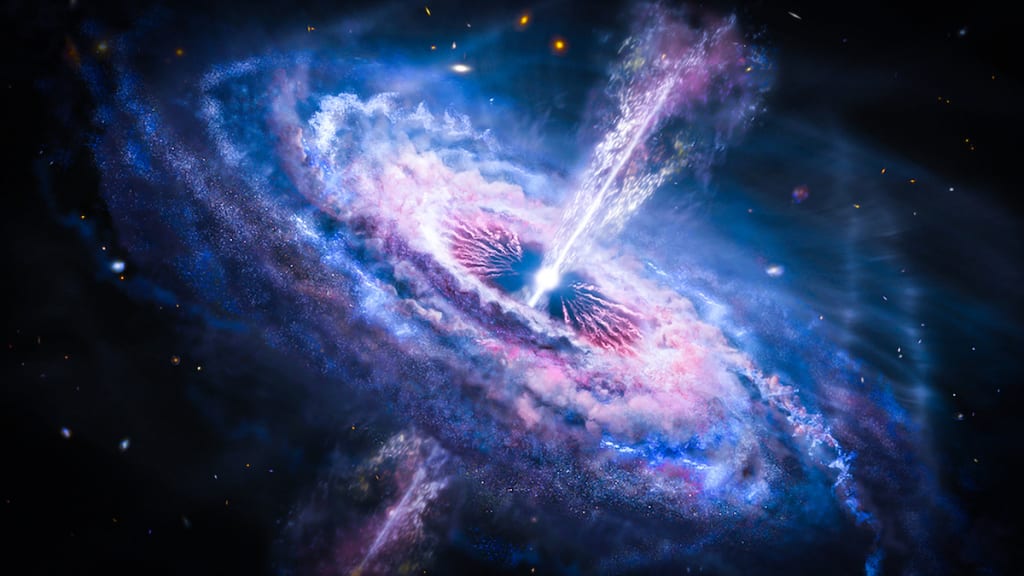QUASAR ORIGINS EXPLAINED BY STUDYING DISTANT GALAXIES
Quasar origins have been a mystery to astrophysicists since they discovered these quasi-stellar radio sources sixty years ago. Find out how a team of researchers discovered that quasars ignite when galaxies collide.

Quasar origins have been a mystery to astrophysicists since they discovered these quasi-stellar radio sources sixty years ago. Find out how a team of researchers discovered that quasars ignite when galaxies collide.
When I was growing up during the space race, the fanciest, most modern televisions came from a brand called Quasar from Motorola. They were one of the first solid state TV sets, and they had their “works in a drawer” instead of the bulky vacuum tubes we used to have to replace all the time.
My dad was more of an RCA guy, mainly because a friend of his ran a TV dealership and repair business, but I remember that Quasar had the coolest ads. I think Motorola chose the brand name “Quasar” because that was the name of a groundbreaking and mysterious space topic.
I don’t think any of us understood what quasars were, but we knew they were “out of this world.” Anything connected with outer space was synonymous with leading-edge futuristic progress back then.
FIRST QUASAR DISCOVERED IN 1960
Astronomers Allan Sandage and Thomas Matthews had discovered the first quasar in 1960. Using radio telescopes, they were studying an object astronomers call 3C 48 when they noticed it had an unusually large red shift compared to other galaxies.
This suggested that galaxies could form and evolved much further away than previously thought. It also seemed to suggest that there was a new kind of star-like radio wave-emitting object out there of which scientists were unaware.
Then, another astronomer, Maarten Schmidt, discovered a similar object in 1963. He was observing the radio source 3C 273. He analyzed its spectrum along with its redshift, allowing him to calculate that 3C 273 was more than 2 billion light-years away.
STARTED CALLING QUASI-STELLAR RADIO SOURCES “QUASARS”
Nobody realized there could be objects that far away before these discoveries. Scientists started calling these quasi-stellar radio sources “quasars” for short.
Over the decades, astronomers have learned that quasars are unimaginably powerful energy sources. In fact, despite having about the same volume as our solar system, they emit more energy than a trillion stars.
Once scientists became familiar with black holes, they realized there was a connection between these regions of intense gravity and the intensely luminous quasars they were trying to understand. We now know that the gas and dust swirling into black holes release the mind-boggling levels of radiation we perceive as quasar radio waves here on Earth.
SUPERMASSIVE BLACK HOLES AT CENTRE OF GALAXIES
Professor Clive Tadhunter is a British astronomer working at the University of Sheffield. He’s been studying the supermassive black holes at the centres of galaxies for more than three decades.
He’s won awards from both the Royal Astronomical Society (RAS) and the American Astronomical Society (AAS). He’s also an RAS past president. Professor Tadhunter and his peers are still puzzled by what triggers the relationship between black holes and quasars.
To learn more about this connection, Professor Tadhunter teamed up with Dr. Jonny Pierce, a Post-Doctoral Research Fellow at the University of Hertfordshire and a group of other researchers. In a study they’ve published in the Monthly Notices of the Royal Astronomical Society, the team compared 48 quasar-hosting galaxies with over 100 galaxies without them.
LARGEST SAMPLE IMAGED WITH SUCH ACUTE RESOLUTION
The team used deep imaging observations from the Isaac Newton Telescope in the Canary Islands. The study became the largest sample of quasars ever imaged using a telescope with such acute resolution.
The images revealed odd distortions near the outer regions of the quasar-hosting galaxies. Reviewing them in detail, the team realized that quasars were arising from galaxy collisions.
There’s a black hole at the centre of most galaxies, including our own. Meanwhile, there’s an tremendous amount of gas and dust orbiting their outer edges, far away from the central black hole.
GALAXY COLLISIONS RELEASE ENORMOUS LEVELS OF ENERGY
Galaxy collisions force this gas and dust into the black hole. Just prior to disappearing, the debris cloud emits an enormous volume of radiation, which is what we experience as a quasar here on Earth.
“Quasars are one of the most extreme phenomena in the universe, and what we see is likely to represent the future of our own Milky Way galaxy when it collides with the Andromeda galaxy in about five billion years,” Professor Tadhunter explained. “It’s exciting to observe these events and finally understand why they occur – but thankfully Earth won’t be anywhere near one of these apocalyptic episodes for quite some time.”
A quasar can have a profound effect on its galaxy. For example, sometimes it pushes away all a galaxy’s gas, preventing stars from forming there for billions of years.
AND ANOTHER THING…
This discovery is another leap forward in humanity’s understanding of what triggers and fuels these mysterious quasi-stellar radio objects. Astrophysicists need to know more about quasars because they’re ultra-bright beacons that can point us back in time to the origin of our universe.
Discovering how quasars form has deepened out understanding of the processes underpinning the cosmos and our place in it. It’s one more aspect of our evolving universe and the interrelatedness of everything it contains.
Dr. Pierce shared this view as he concluded by saying, “Quasars play a key role in our understanding of the history of the Universe, and possibly also the future of the Milky Way.”
We always have more to learn if we dare to know.
Learn more:
Astronomers solve the 60-year mystery of quasars – the most powerful objects in the Universe
Galaxy interactions are the dominant trigger for local type 2 quasars
Spiraling Stars Help Explain Early Universe
Big Bang Afterglow Showing How Galaxies Form
About the Creator
David Morton Rintoul
I'm a freelance writer and commercial blogger, offering stories for those who find meaning in stories about our Universe, Nature and Humanity. We always have more to learn if we Dare to Know.






Comments
There are no comments for this story
Be the first to respond and start the conversation.